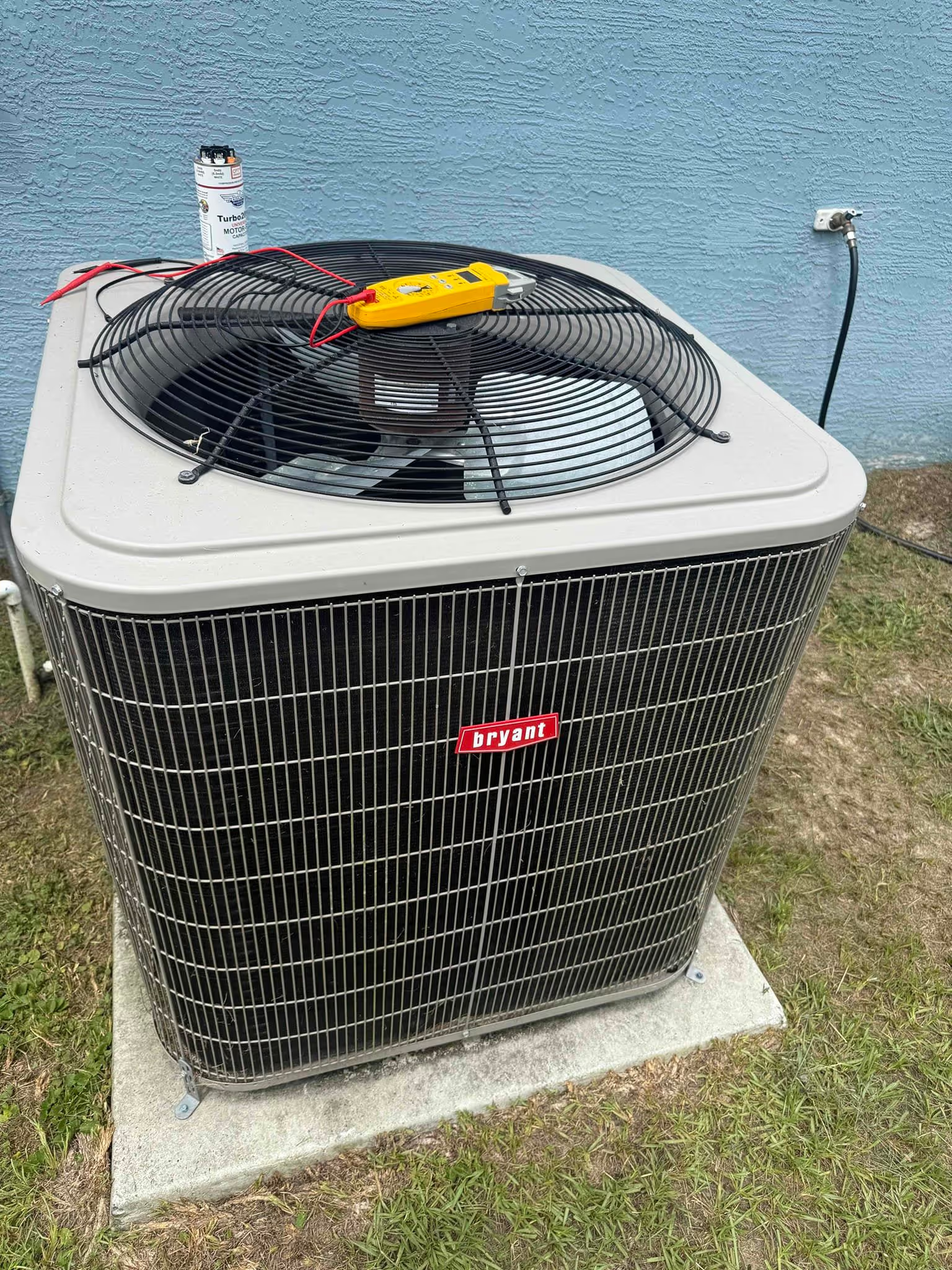


FREE Water Heater
With every whole house repipe purchase. Free brand-new water heater or credit towards a tankless water heater.
.svg)
.svg)
.svg)
.svg)



With every whole house repipe purchase. Free brand-new water heater or credit towards a tankless water heater.
.svg)
.svg)
.svg)
.svg)

Your air conditioning system works hard all summer long, and small problems can quickly turn into expensive emergencies if left unchecked. According to the U.S. Energy Information Administration (EIA), air conditioning represents about 19 % of the total electricity use in U.S. homes, making timely repairs and preventive maintenance especially cost‑sensitive.
October offers the perfect window for AC repair because technicians have more availability and can catch issues before they become costly breakdowns during peak season. Many homeowners wait until their system completely fails, but this approach often leads to emergency repair bills that could reach thousands of dollars.
Smart property owners schedule AC inspections and repairs during the fall months when demand is lower and prices are more reasonable. Minor issues like refrigerant leaks, worn belts, or dirty coils might seem harmless now, but they can cause major system failures when you need cooling most. The difference between a small repair bill in October and a full system replacement in July can be substantial.
The key lies in taking action before small problems escalate into system-wide failures that leave you sweating through the next heat wave.
In this article, you’ll learn how scheduling air conditioning repair in October can reduce costs, improve system performance, and prepare your AC for next summer.
Below, we’ll walk through each important aspect.
Why October is the smart month for AC repair
Problems that seem minor now but spike costs later
Costs in plain English and the $5,000 AC rule
What an October AC inspection should include
Picking ac repair companies you can trust
Keep reading! Understanding when to repair versus replace your AC unit, what warning signs to watch for, and how to choose reliable repair companies can save both money and comfort.
October offers the perfect timing for AC repairs with lower service costs, reduced wait times, and cooler temperatures that make troubleshooting easier. Homeowners can address problems without the pressure of emergency situations while preparing their systems for peak efficiency next summer.
AC repair companies face their slowest period in October. Summer demand drops significantly as temperatures cool down. This creates opportunities for homeowners to schedule repairs quickly.
Most HVAC technicians have open schedules during fall months. They can often provide same-day or next-day service appointments. Emergency surcharges disappear since repairs are not urgent.
October pricing advantages:
Contractors often offer fall discounts to maintain steady business. They may bundle services like duct cleaning or maintenance at reduced rates. Payment plans become more flexible during slower months.
October's mild temperatures create ideal conditions for diagnosing AC problems. Technicians can run full system tests without overheating equipment. Homeowners can live comfortably while repairs happen over several days.
Problems become easier to spot when systems are not under extreme stress. Refrigerant leaks show up clearly in moderate weather. Electrical issues surface without the strain of constant operation.
Diagnostic benefits in October:
Homeowners can take time to research repair options. They avoid rushed decisions that lead to poor choices. Multiple opinions from contractors become possible without suffering through hot weather.
October repairs prevent small problems from becoming expensive failures. A minor refrigerant leak fixed now saves hundreds in emergency repairs next July. Clean coils and proper airflow reduce energy costs by 15-25%.
Systems repaired in fall operate at peak efficiency from day one of cooling season. They use less electricity and maintain consistent temperatures. Utility bills stay lower throughout the summer months.
Energy savings from October repairs:
Well-maintained AC units last 3-5 years longer than neglected systems. October repairs extend equipment life and delay costly replacements. Regular fall maintenance prevents 80% of summer breakdowns.
Small AC problems often mask bigger issues that cost thousands to fix later. A system that runs but doesn't cool well, weak airflow, or strange noises usually signal failing parts that will break down completely without prompt attention.
When an air conditioner runs constantly but doesn't cool the house, the problem often lies with the refrigerant system. Low refrigerant levels force the system to work harder and longer to reach the set temperature.
A small refrigerant leak might only cost $200-400 to fix initially. However, when refrigerant runs low, the compressor overheats and fails. Compressor replacement typically costs $1,500-3,500.
The evaporator coils can also freeze when refrigerant levels drop. This damages the coils and creates water damage inside the system. Ice formation blocks airflow and puts extra strain on the blower motor.
Another common cause is a failing compressor that still runs but can't compress refrigerant properly. Early signs include the outdoor unit running but not producing cold air. Catching this early allows for repairs, but waiting usually means full replacement.
Dirty evaporator coils act like insulation around the cooling system. This forces the AC to run 15-30% longer to cool the same space, which increases energy bills and wears out parts faster.
When coils stay dirty, the system can't transfer heat properly. The compressor works harder to compensate, leading to premature failure. Professional coil cleaning costs $100-300, while compressor replacement costs thousands.
Clogged air filters also reduce airflow and make the system strain. A $20 filter replacement prevents expensive repairs to the blower motor and heat exchanger.
Blocked return vents or damaged ductwork creates similar problems. The system pushes against resistance, overworking the blower motor and reducing efficiency by up to 40%.
Strange noises from an AC unit usually indicate mechanical problems that worsen quickly. Clicking sounds often mean the capacitor is failing, which costs $150-400 to replace but can damage the compressor if ignored.
Grinding or squealing noises typically point to worn motor bearings. A motor bearing replacement might cost $200-500, but waiting until the motor seizes completely requires full motor replacement at $800-1,200.
Rattling sounds often indicate loose parts or debris in the system. Small fixes prevent damage to expensive components like the condenser fan or compressor.
Humming without the unit starting usually signals a failed capacitor or motor. The system draws power but can't start properly, which can trip breakers and damage electrical components throughout the AC system.
AC repair costs can range from simple fixes under $200 to major repairs over $1,000, while the $5,000 rule provides a clear formula to decide between fixing or replacing your system.
Basic AC repairs typically cost between $150 and $800 for common issues. Simple problems like replacing a capacitor or cleaning coils fall on the lower end.
The U.S. Department of Energy estimates that effective operation and maintenance of HVAC systems can cut energy costs by 5 % to 20 % annually, depending on system condition and use.
More complex repairs can reach $1,500 or higher. These include compressor replacement, refrigerant leaks, or electrical system repairs.
Common repair costs:
Several factors affect repair costs. The age of the system plays a major role since older parts are harder to find and more expensive.
System size and brand also matter. Larger units and premium brands typically cost more to repair. The complexity of the problem and local labor rates add to the final bill.
The $5,000 rule uses simple math to guide repair decisions. Multiply the system's age in years by the estimated repair cost.
If the result exceeds $5,000, replacement often makes more sense than repair. If it stays under $5,000, repairing may be the better choice.
Example calculations:
This rule works because it considers both cost and remaining system life. Older systems need more frequent repairs and have lower efficiency.
The formula helps avoid spending good money on systems near the end of their useful life. Most AC systems last 15-20 years with proper maintenance.
Beyond the $5,000 rule, other factors affect the repair-or-replace decision. Energy efficiency improvements can justify replacement even when repairs seem reasonable.
Newer systems use 20-40% less energy than units from 10-15 years ago. Monthly savings on electric bills help offset replacement costs over time.
Consider replacement when:
Stick with repairs when:
Warranty coverage also influences decisions. Systems under warranty make repairs more attractive since parts costs drop significantly.
Think about long-term plans for the home. If selling within a few years, a new system adds value and appeal to buyers.
An October AC inspection focuses on three main areas that prepare your system for the months ahead. Technicians check refrigerant levels and electrical components, clean coils and test airflow, then provide detailed documentation of their findings.
Technicians measure refrigerant levels using specialized gauges to ensure proper cooling capacity. Low refrigerant often signals leaks that need repair before they cause major damage.
Electrical testing covers all connections, contacts, and control boards. Technicians check voltage levels at the unit and test capacitors that help motors start properly. They also inspect wiring for signs of wear or corrosion.
Key electrical components tested:
Drain line cleaning removes buildup that blocks water flow. Technicians use specialized tools to clear clogs and flush the system. They check the drain pan for cracks and test the overflow switch.
A clean drain system prevents water damage and reduces humidity problems inside the home.
Coil cleaning removes dirt and debris from both evaporator and condenser coils. Dirty coils reduce efficiency and strain the system during operation.
Technicians use brushes and cleaning solutions designed for AC coils. They clean the outdoor condenser coil and the indoor evaporator coil carefully to avoid damage.
Airflow measurements tell technicians if the system moves enough air for proper cooling. They use instruments to measure air volume at vents and check static pressure in ducts.
Airflow testing includes:
Poor airflow often means dirty filters, blocked ducts, or blower problems that need attention.
The inspection report lists all findings with clear descriptions of any problems. Photos show the actual condition of components so homeowners understand what needs attention.
Technicians include recommendations for repairs and maintenance with priority levels. They explain which issues need immediate action and which can wait.
The report covers system performance data, including temperatures and pressures measured during the visit. This information helps track system health over time and plan future maintenance needs.
Finding reliable ac repair companies requires checking specific credentials and asking targeted questions. Smart homeowners verify licenses, get clear pricing details, and understand warranty terms before hiring any contractor.
Licensed contractors must show valid HVAC certifications for your state. Ask to see their license number and verify it online through your state's licensing board.
Insurance coverage protects you from liability. Request proof of both general liability and workers' compensation insurance. Never hire companies without proper coverage.
Essential credentials to verify:
Honest companies provide written estimates before starting work. The estimate should list parts, labor costs, and total project price.
Avoid contractors who quote prices over the phone or demand full payment upfront. Reputable businesses typically ask for small deposits only.
Real warranties cover both parts and labor for specific time periods. Quality companies offer at least one year on major repairs and longer terms on new equipment installations.
How long has the company operated in your area? Established businesses with local roots often provide better service than new companies.
Do they offer emergency services? Reliable contractors provide after-hours support for urgent cooling problems.
Key questions to ask:
Ask about their diagnostic process. Professional technicians should explain what they found and why specific repairs are needed.
Request references from recent customers. Good companies gladly share contact information for satisfied clients in your neighborhood.
Local service companies often respond faster than large national chains. They understand regional climate challenges and common equipment problems.
Look for businesses that service multiple equipment brands. This shows technical expertise across different systems and manufacturers.
Companies focused on long-term relationships offer maintenance plans and seasonal tune-ups. These services prevent major breakdowns during peak cooling months.
Check online reviews on multiple platforms including Google, Better Business Bureau, and Trustpilot. Look for patterns in customer feedback about response times and work quality.
Contact your local Better Business Bureau to verify company ratings. This helps identify any unresolved complaints or business practice issues.
Homeowners who understand air conditioning repair basics can make better decisions when problems arise. Knowing when to call professionals versus attempting simple fixes saves both time and money.
The decision between repair and replacement depends on several factors. Units over 10 years old with frequent breakdowns often cost more to maintain than replace.
Professional technicians can diagnose problems accurately and provide realistic timelines. They also offer warranties on their work, which protects homeowners from additional costs.
Weather conditions affect repair schedules during peak seasons. Planning ahead helps avoid emergency service calls during the hottest months.
Understanding repair costs helps homeowners budget for maintenance. Simple fixes like filter changes cost much less than compressor replacements or refrigerant leaks.
Working with licensed HVAC contractors ensures repairs meet safety standards. Proper repairs extend equipment life and maintain energy efficiency throughout the cooling season.
Book your October AC inspection today to avoid emergency repairs next summer and keep your cooling system running efficiently.